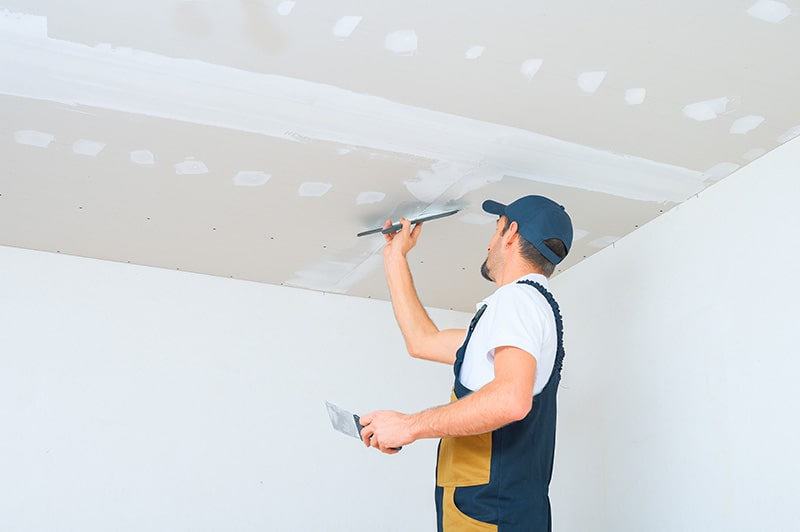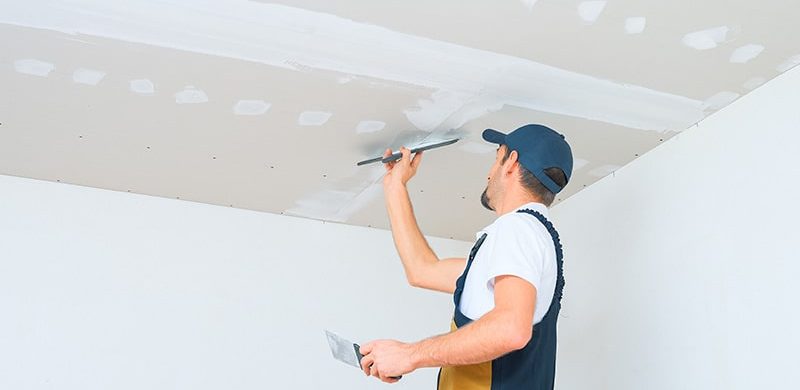COMPARE PRICES AND SERVICES TO RENOVATE ROOMS, FLOORS, WINDOWS, ETC.

GET 3 QUOTES FOR YOUR RENOVATION AND WORKS

"*" indicates required fields


The cost of installing drywall or gypsum in 2024

Whether you are renovating a house dating from the last century or building a house from the foundation to the roof, you will surely need gypsum on the walls!
Also called “drywall,” gypsum is a synthetic material that has been in the construction industry for decades now and has emerged as the default material for home builders.
In the past, only one option was offered on the market, namely regular gypsum. More modern construction processes have made it possible to diversify gypsum products including water-repellent gypsum, fire-resistant gypsum, sound-absorbing gypsum, and more!
See which type of gypsum you need for each room in your home and the price of different gypsum installation contractors!
Compare Home Quotes can help you compare the prices of different contractors, free of charge! Just fill out the online form on this page to receive 3 free quotes!
Prices for Gypsum or Drywall Installation with a Contractor

Are you planning a home renovation and need gypsum boards installed? This is not a task that you can easily do on your own. You will have more peace of mind if you entrust this work to an experienced contractor.
Before you start searching for a contractor, you might want to know how much drywall installation costs.
Estimating the cost of drywall installation
To find an accurate price for laying gypsum, you need to know the size of the area. You can measure the surface area of the ceilings and walls to know the number of panels required.
Please know that the number of windows and doors will not affect the estimate.
Once you determine the number of panels you need, a contractor can estimate the cost of the labour and materials. Most areas use panels that are 4 feet x 12 feet but wet areas such as a bathroom or a kitchen may need 4 feet x 8 feet water-repellant panels. .
Types of gypsum panels and their prices
The type of gypsum panel you choose will also affect the cost of your project. Standard panels are cheaper but other panels such as fire-resistant, water-repellant, of flexible gypsum panels are more expensive.
For instance, water-repellant or waterproof panels are around $18 to $20 per panel. Fire-resistant panels generally used for commercial areas cost $22 per panel, on average.
Stairwells, arches, and walls with irregular lines may require flexible panels that are more expensive than standard ones. For your guidance, standard gypsum panels cost around $16 per panel.
Check the table below for the average cost of standard gypsum installation based on size of the area:
Surface Area | Average Cost |
1,000 square feet | $2,000 to $2,500 |
2,000 square feet | $4,000 to $4,500 |
3,000 square feet | $6,000 and up |
4,000 square feet | $8,500 and up |
5,000 square feet | $10,000 and up |
Average Prices for different types of gypsum
Type of gypsum panel | Average Price per Panel |
Standard gypsum | $12 |
Water-repellant gypsum | $18 – $20 |
Fireproof gypsum | $22 |
Soundproofing gypsum | $24 |
Durock panels | $42 |
Don’t decide just on price for your gypsum boards!
The evaluation of a construction and renovation project is more complex than a simple calculation per square foot depending on the type of gypsum chosen! Contractors consider many other variables specific to your project!
If you would like to obtain a detailed quote for your gypsum installation project, a very simple solution is available to you: fill out our online request form to receive multiple quotes!
Steps for Installing Gypsum Panels

Drywall or gypsum installation can be a bit complicated for DIY enthusiasts. Precision is necessary to ensure a satisfactory outcome.
To give you an idea of the work that it entails, here are the steps for installing standard gypsum panels.
Preparation of the tools required:
Prepare the tools and materials for gypsum panel installation as follows:
- A drywall knife,
- A level,
- Lifter for the panels,
- Measuring tape,
- Metal cutter,
- T-square,
- Adhesive,
- Drill for drywall with screw setter,
- Hammer (for nails),
- Corner beads for junctions,
- Drywall panels.
Check for obstacles:
Check the electrical wiring, plumbing, and power switches to know what to avoid beforehand.
Plan the number of gypsum panels required:
Measure the horizontal and vertical areas to determine the total area and divide this with the size of the gypsum panel you plan to purchase.
Cut the gypsum panels:
Use a drywall knife to cut the paper on the board. Let the T-square guide you. Position the panel down and press as you run the knife through the lines traced earlier. Sand the sides of the panels to remove uneven areas.
Installation of the gypsum panels:
Begin with the panels for the ceiling and drive the screws into the panels. Don’t rip the paper. Attach the crews close to the sides so that they can be covered with paper later on with the drywall compound.
Use a panel lifter to keep the panels stable on the ceiling. Make sure the joints are level then apply adhesive onto the surface.
Find out where the panels will be connecting with the beams. The panels need to be at least a quarter of an inch away from the junctions. Screw the boards on every 12 inches or use nails every 7 inches or so to keep them at distance from the wall’s edge.
Installation of the wall panels:
Install wall panels horizontally to reduce the number of joints used for the process. Leave at least ½ inch between the panel’s edge and the floor. Separate the panels and the wall corner to make sure that the board will cover ½ of the wall beam’s surface before screwing in. This will also ensure the panel is securely attached.
Prepare openings for outlets, electric panel, and lamps
Get the measurements for the exact places where openings are needed. With the drywall knife, cut the panel carefully to avoid damage.
Make openings for windows and doors.
Do the same process for windows and doors, taking care to remove the frames to avoid damage.
Application of the corner beads
After setting up the panels, install the corner beads for the exterior wall. Measure the height of the wall and cut the inner corner bead using a metal cutter.
Press the corner bead directly at the junction point and before it is fixed onto the surface, make sure that the panel edges are smooth. The inner corner bead must be perpendicular to the ceiling before it is attached permanently.
Does this seem like a lot of work to do? We totally understand.
Check for reputable professionals to install drywall for your home renovation by filling out the short online form on this page.
Durock Cement Panels: The Pros and Cons
Durock cement panels are used for the design of walls – they are made with 3 materials: Portland cement, fiberglass, and a polymer coating. Although its popularity is still limited, it is one of the strongest and most durable options available.
Advantages of Durock cement board: The water resistance of Durock cement board is unmatched; its integrity is not compromised by mere exposure. In addition, it has non-combustible materials. These properties not only avoid premature degradation, but also a significant prevention against mold.
What is Durock cement board used for? It is used primarily to solidify the walls in areas such as the bathroom or behind the fireplace for superior thermal insulation.
Disadvantages of Durock cement board gypsum board: Since gypsum board is denser and heavier than standard gypsum boards, it is sometimes necessary to install stronger reinforcements to support the extra weight.
Of course, Durock cement boards are much more expensive than the average gypsum panels.
The best alternatives to Gypsum for Walls

Knotty pine paneling used in older homes and log cabins have a unique appeal. It is durable and has timeless style. Is it a good alternative to using gypsum panels for walls in the home?
The price of materials for building a gypsum ceiling is significantly lower than that of a natural wood ceiling. This is all the more true when you see the variety of gypsum panels available on the market.
Even if you choose a lower quality of wood, the price will still be more expensive than a gypsum ceiling, even taking into account the necessary seams, sanding, dusting, and numerous coats of paint.
Plywood with maple or birch veneer are also excellent alternatives as they are easy and quick to install and has a higher aesthetic appeal than gypsum panels. They use wood trim for joints instead of paper tape and adhesive compound.
What are the advantages of opting for a wooden ceiling or walls? Wood is more aesthetically pleasing to the eye than gypsum board. This is obviously purely subjective, but what is less so is the fact that wood ceilings help added give value to your home if you are willing to pay the higher price.
Hiring Gypsum Contractors vs. DIY Installation
If you don’t have the skills or experience for installing gypsum or with general construction, it is advisable to hire a gypsum contractor.
If you do a DIY job, the panels may be installed incorrectly or not evenly. If you encounter problems and call in a professional to resolve the problem later on, it may cost you even more.
Compare Home Quotes can connect you with reliable and experienced drywall contractors for your project! We have reputable partners all over Quebec, Ontario, and anywhere in Canada!
You can receive free and no-obligation quotes from trusted professionals so you can compare to save time and money. Just fill out the short online form below to get started.
Comments are closed.
COMPARE PRICES AND SERVICES TO RENOVATE ROOMS, FLOORS, WINDOWS, ETC.

GET 3 QUOTES FOR YOUR RENOVATION AND WORKS

"*" indicates required fields


Copyright© 2024 Compare Home Quotes.
Oolong Media






